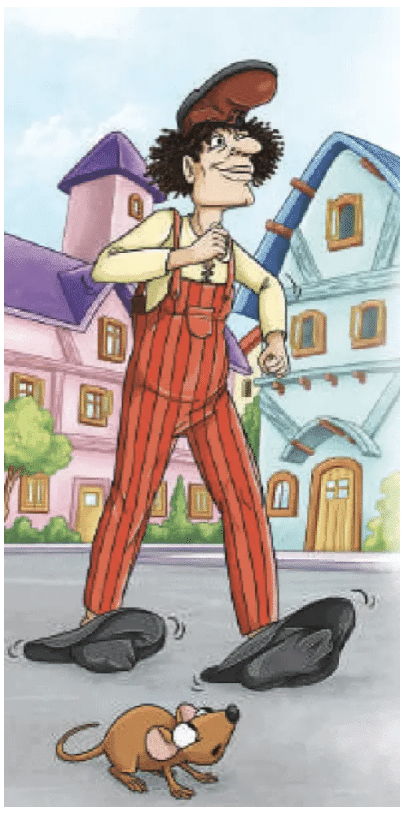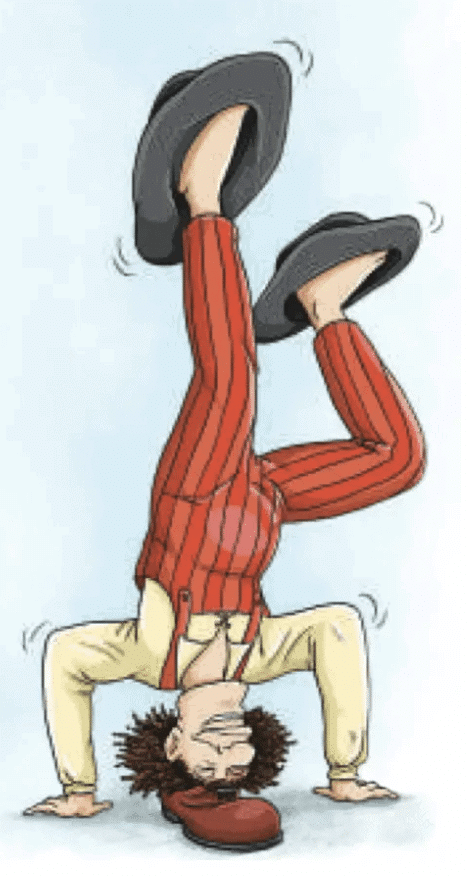Class 7 English Unit 2 Short and Long Answer Questions - A Funny Man
Short Answer Questions
Q1: What does the funny man wear on his head and feet?
Ans: The funny man puts a shoe on his head and hats on his feet, making him look very strange. This unusual outfit catches the poet’s attention as he walks down the street. It shows he likes to be different and doesn’t follow the usual rules.

Q2: How does the funny man greet the poet politely?
Ans: The funny man greets the poet politely by raising the shoe on his head, as if tipping a hat, and smiling at her. Even though he looks odd, he is kind and respectful, which surprises the poet. The mix of his polite action and strange appearance adds humour and makes the moment funny.
Q3: What does the funny man offer the poet instead of a rose?
Ans: Instead of a rose, the funny man offers the poet a currant bun, holding it to her nose like a flower. He jokingly calls the bun a rose, surprising her with his playful humor. This silly act shows how much he enjoys fun and surprising others, making the moment feel light-hearted.
Q4: How does the poet react to the currant bun?
Ans: The poet reacts to the currant bun by staggering back against the wall in surprise. She then cleverly responds, saying she’s never seen a “rose” with such a “funny looking smell.” By playing along with the man’s joke, she shows her amusement and quick wit, enjoying the silly interaction with him.
Q5: What does the funny man do when asked about his hats?
Ans: When the poet asks why he wears hats on his feet, the funny man doesn’t answer directly. Instead, he turns around and hops home on his head, a ridiculous and funny action. This unexpected response adds to his quirky character, showing his playful nature and leaving the poet with a sense of delight.
Long Answer Questions
Q1: How does the funny man’s appearance and actions create a humorous tone in the poem?
Ans: The funny man’s appearance and actions make the poem funny because they are so silly and break the usual rules of behaviour. From the beginning, his choice to wear a shoe on his head and hats on his feet is a funny twist on normal clothing, catching attention and creating a playful feeling. His polite gesture of raising the shoe to greet the poet adds to the humour, mixing respect with silliness. Offering a currant bun as a “rose” and holding it up to the poet’s nose is a surprise, mixing the idea of a flower with bread. His actions get even sillier when he sits on the ground to sing a song with a “funny feeling sound” and later hops home on his head. These funny behaviours, described with playful words like “funny sounding sight” and “funny looking smell,” keep the tone light and fun. The poet’s reactions, like staggering back and joking about the bun, add to the humour, making readers laugh at the man’s playful imagination.
Q2: Why does the poet find the funny man’s behaviour surprising, and how does she respond to it?
Ans: The poet is surprised by the funny man’s behaviour because it breaks all expectations of normal behaviour, mixing politeness with ridiculous actions. His appearance—wearing a shoe on his head and hats on his feet—shocks her and is unlike anything she has ever seen, described as a “funny sounding sight.” Despite this, his polite manners, like raising his shoe and smiling, stand in contrast, catching her off guard. When he offers her a currant bun as a “rose,” holding it to her nose, it’s another unexpected twist, as she was expecting a flower but gets bread instead. His singing on the ground and hopping home on his head leave her even more surprised by his randomness. The poet responds with a mix of surprise and playfulness, staggering back when given the bun and joking that she’s never smelled a “rose” quite like that. Her curiosity about his hats and his absurd answer—hopping on his head—delighted her. She enjoys his silliness and adds her own humour, making the interaction fun and reinforcing the poem’s playful tone.

Q3: How does the funny man’s interaction with the poet show his playful personality?
Ans: The funny man’s interaction with the poet shows his playful personality through his silly actions and humorous gestures that focus on fun rather than following rules. He greets her politely by raising the shoe on his head and smiling, mixing respect with absurdity in a way that makes her laugh. Calling her “Your Highness” and offering a “rose” that turns out to be a currant bun held to her nose shows his love for surprising others with playful twists, turning a formal gesture into something quirky. His exaggerated politeness and unusual gift highlight his desire to entertain. When he sits on the ground to sing a song with a “funny feeling sound,” he shows he’s carefree and doesn’t care about what others think. When asked about his hats, he gives a silly answer and hops home on his head, sealing his playful character. Each of his actions is meant to entertain and bring joy, reflecting a personality full of imagination and happiness, inviting the poet and readers to join in his fun world.
Q4: What role does the poet’s clever response to the currant bun play in the poem’s humour?
Ans: The poet’s clever response to the currant bun adds to the poem’s humour by showing her quick wit and keeping the playful exchange going. When the funny man offers the bun as a “rose” and holds it to her nose, she’s initially shocked but doesn’t reject his odd gesture. Instead, she humorously comments that she’s never seen a “rose” with such a “funny looking smell.” This clever reply plays along with his joke, blending senses by mentioning a smell that can’t be “seen.” Her playful language mirrors the man’s quirky style, creating a shared moment of fun. The poet’s response shows she’s open to his imaginative world, making the interaction a two-way exchange of humour. By matching his absurdity with her own wit, the poet enhances the comedic effect and invites readers to enjoy the light-hearted banter, reinforcing the poem’s message to embrace life’s playful moments.
Q5: What lessons about imagination and joy can we learn from the funny man’s actions in the poem?
Ans: The funny man’s actions in the poem teach important lessons about embracing creativity and finding joy in being different. His choice to wear a shoe on his head and hats on his feet shows he’s not afraid to break the rules, encouraging readers to express themselves in unique ways. His playful acts, like offering a currant bun as a “rose” and hopping home on his head, show that imagination can turn ordinary moments into fun surprises that make people smile, as seen in the poet’s amused reactions. Singing a song on the ground and calling the poet “Your Highness” reflects his carefree attitude, suggesting that true happiness comes from not taking life too seriously. The funny man’s ability to make the poet laugh with his silliness shows how imaginative actions can spread joy. The poem’s message—that it’s okay to be different and have fun—encourages readers to embrace their own quirky ideas and share the joy with others. By celebrating the man’s whimsical behaviour, the poem inspires us to use imagination to bring lightness into life and to approach the world with a playful, open spirit.
|
55 videos|465 docs|76 tests
|
FAQs on Class 7 English Unit 2 Short and Long Answer Questions - A Funny Man
| 1. What is the main theme of the article "A Funny Man"? |  |
| 2. Who is the central character in "A Funny Man," and what makes him special? |  |
| 3. How does the article illustrate the impact of humor on people's lives? |  |
| 4. What lessons can readers learn from "A Funny Man"? |  |
| 5. Can humor be considered an essential skill? Why or why not, according to the article? |  |






















